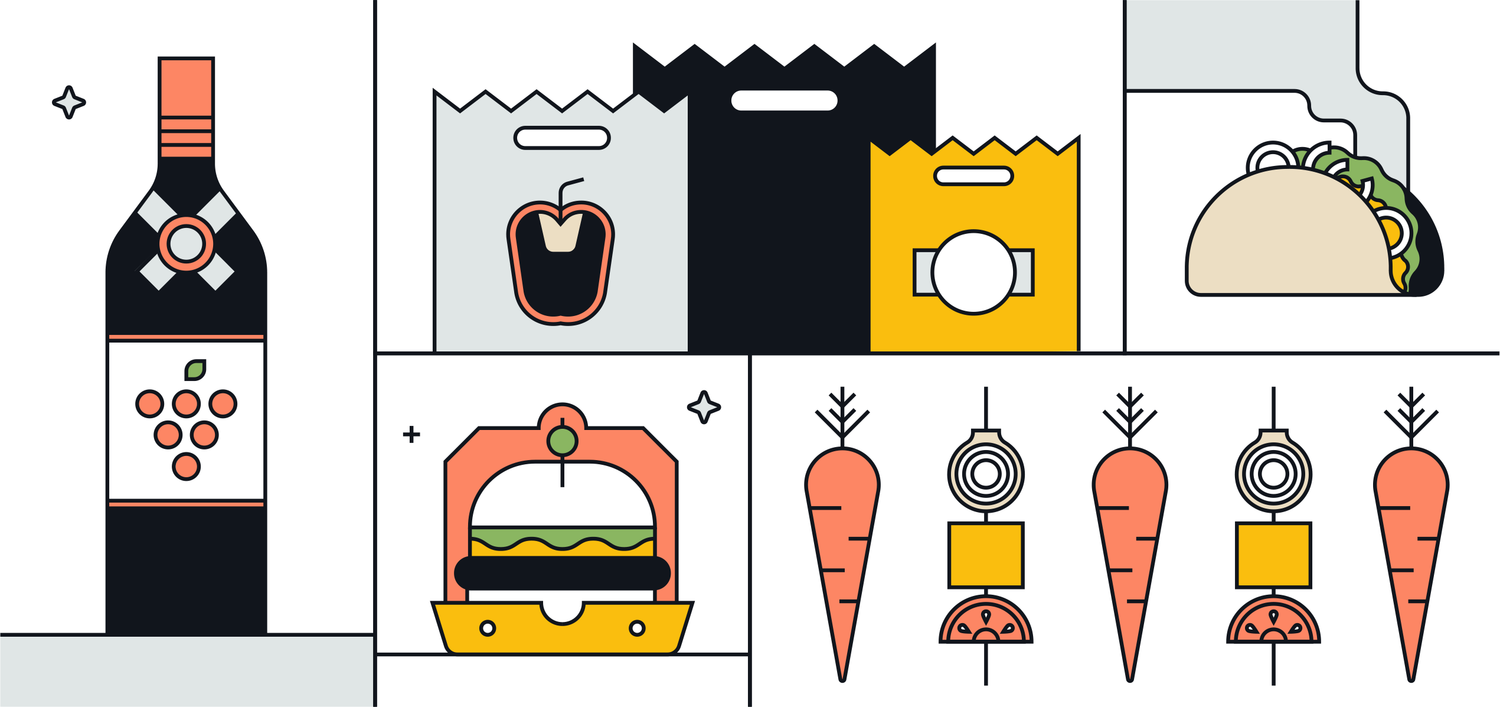Food Box Subscription Services: Industry Overview and Analysis of 4 Leading Companies
It’s the New Year… and this time of the year is about looking forward and finding ways to improve your quality of life. It means preparing to dominate your list of goals just a liiiittle bit more in the year to come. For those with #healthgoals, it means tightening up on diet and exercise… and meal kit subscriptions are a great way to save time when time is money.
For the 40 percent of Americans who will partake in the annual tradition of setting New Year’s Resolutions, food is big on the list. Most people have some variation of healthier living high atop their list of goals, whether that’s eating better, exercising, or finding a more satisfying work-life balance. In fact, #healthgoals took the number two spot as the most popular New Year’s Resolution for 2018, right behind saving money.
There’s some good news on the healthy living front. Convenience food no longer has to mean fatty burgers or microwave meals. Food subscription services are a popular alternative to both the grocery store and the drive-thru. Now anyone, even those of us who are knee-deep into full-on 7 PM to 2 AM hustle-like-you-mean-it lifestyles, can get fresh, healthy, high-quality food delivered direct to our doorsteps, with everything needed to put together amazing meals for the solo diner or a family.
Awesome bonus: Most food subscription boxes come with easy-to-follow recipe cards.
In this post, we’re taking a look at the food subscription box industry (aka meal subscriptions, meal kit delivery, food boxes) – the stats, the figures, the facts. And we’re checking out examples of the smart marketing tactics food subscription services have used to boost awareness and enlist subscribers.
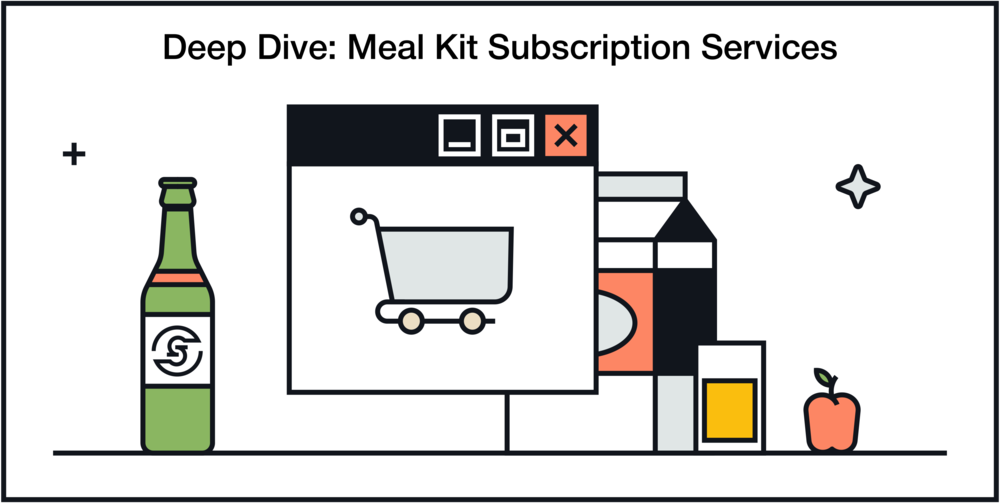
The Online Meal Kit Delivery Industry In a Nutshell
There are dozens of food subscription services on the market and dozens of dozens of box subscription companies that specialize in delivering everything from shave kits to perfume to gaming gear.
FYI, there are three different variations of subscription services – replenishment, access, and curation.
Replenishment services focus on keeping you well-stocked with the important, everyday items like razors like Dollar Shave Club and 1800CONTACTS.
Access services give users access to their services each month like Netflix, Amazon Prime etc.
Curation services give users new and exciting items or experiences each month like Birchbox or Loot Crate.
Food boxes generally fall into the curation category, although some may work on a replenishment model as well.
At the end of 2017, the five most-trafficked box subscription services shipped products across multiple verticals, including beauty, food, apparel, and personal hygiene.
Look at how the following charts show the differences between the subscription box retailers that are visited most, versus the subscription box retailers with the most unique visitors.
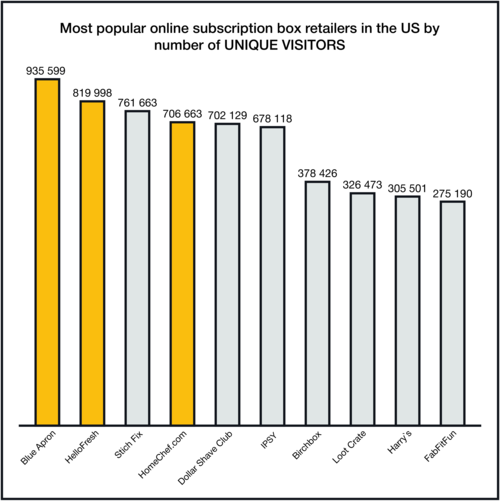
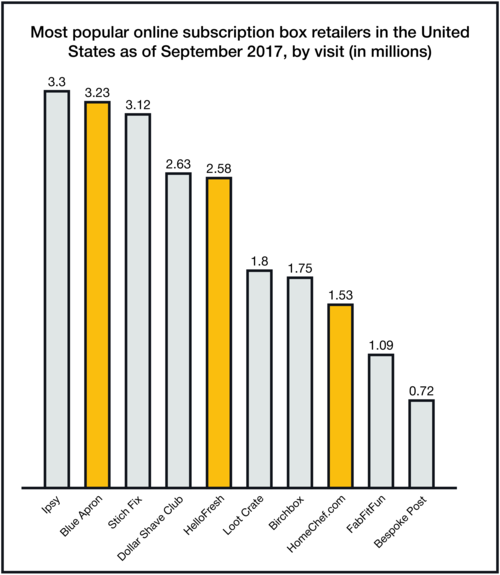
MARKET SIZE
Subscription meal boxes, in particular, are quickly becoming the new fast food… only without the guilt and requisite gym membership. In 2015, meal kit delivery sales alone reached $1 billion. Impressive, until you read enthusiastic predictions that push annual revenue for the direct-to-door meal kit delivery market to $10 billion by 2020 (that’s, like, a year away).
Take a look at the three meal kit services in the chart above, Blue Apron, HelloFresh, and Home Chef. Together, they’re getting more than 7 million monthly visitors) to their sites. That’s a full third of the total web users visiting any box subscription site.
According to Statista, 27 percent of Internet users purchased restaurant and meal kits in 2016 to take advantage of the convenience of getting boxes of pre-measured ingredients with recipes in tow to prepare restaurant-quality meals at home. Meal kits typically cost 30 percent less than what it would cost to have the same meal out.
Food boxes are attractive because they deliver a varied menu of meal options to a wide range of target customers. Of course, as with anything else online, subscribers can also order specific types of meals, including:
- Organic (non-GMO)
- Veggie-centric
- Paleo
- Low-carb
- Specialty Diets
- Farm-to-Table home meal prep
So, while a company like Purple Carrot specializes in helping subscribers prepare plant-based meal kits, Green Chef offers organic paleo meals. Other services still offer subscribers a little of everything. The average price per meal kit hovers right around $10 per person, give or take a buck or two (and depending on the company, niche(!!), and amount of food a subscriber orders).
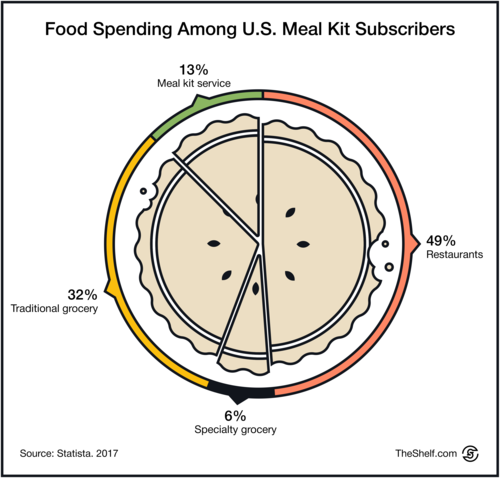
Target Customer
Packaged Facts lists age as THE MOST important factor in identifying shoppers who are most likely to subscribe to fresh meal kit subscription services.
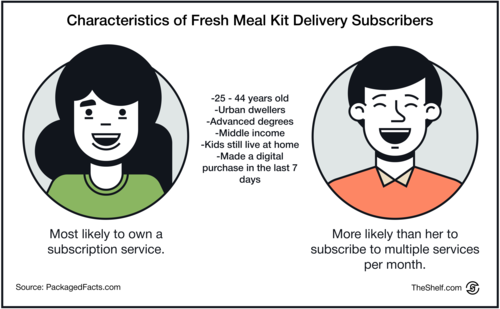
Subscribers tend to be partnered parents between the ages of 25 and 44 years old who live in urban environments, have mid-range incomes, advanced degrees, and school-aged children still living at home. Interestingly, while women are more likely to own a subscription service, men are more likely to subscribe to multiple services each month.
Meal kit subscribers are typically people who are comfortable shopping online. In fact, most of them have purchased something online in the seven days leading up to their purchase of a meal kit.
A Growing Market Endures Growing Pains
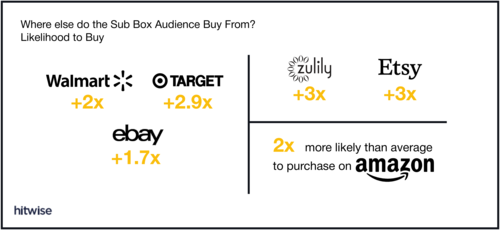
Source: Subscription Boxes in 2018 – Hitwise
We had to be careful digging up stats about this industry because between 2017 and 2018, the meal kit delivery market as a whole fell a bit from grace, and several issues continue to affect meal kit delivery companies.
STANDING OUT CROWDED MARKET
While having a box of fresh meal ingredients is a relatively new trend, these types of meal kit subscriptions actually fall under the grocery store sector. So, yes the direct competitors in this space are other existing web-based food box subscription services, but these companies are increasingly having to compete against (or partner with) grocery store chains like Kroger and other retailers that are moving into the meal kit market.
In 2018, Walmart announced it would be rolling out its own meal kits to 2,000 store locations. As well, a growing number of grocery store chains are slowly but surely making the transition into online grocery sales.
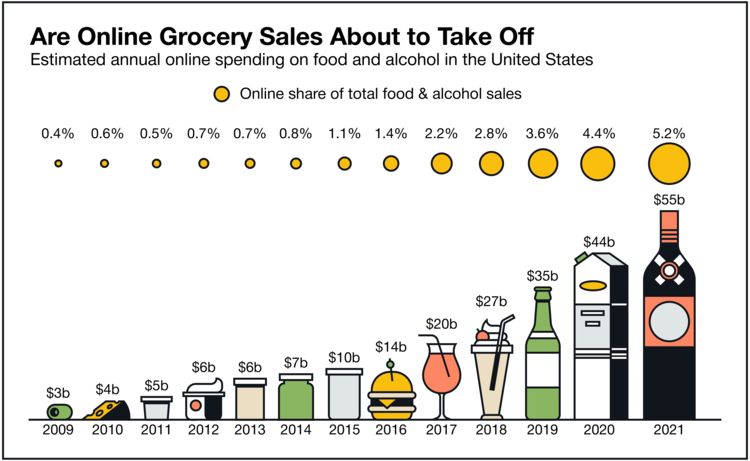
The Motley Fool estimates there are more than 150 food subscription box companies in the U.S. alone, and only 10 percent of American consumers have actually tried a meal kit delivery service. For companies that aren’t yet household names, they need a strategy to stand out or they will be forced to compete on price to win business over the other unknown companies. It’s a veritable race to the bottom.

LOWERING THE COST OF DELIVERY
When Chef’d unexpectedly shut down in July 2018, it laid off employees and halted operations effective immediately. Chef’d was one of the first subscription food box services in the market to sell food meal kits to both home delivery subscribers and grocery stores. Chef’d also allowed subscribers to select meal kits from a menu of thousands of options. Its sudden shutdown rocked the meal kit delivery market, which was also in the midst of sorting out the rapid decline in growth of the market’s leading company, Blue Apron.
Brittain Ladd wrote a piece for Forbes.com addressing the ongoing challenges with meal kit delivery companies. In it, Ladd wrote, “The Achilles heel of meal-kit companies is that the business has exceptionally high customer acquisition costs, high operational and supply-chain costs, high logistics costs and low customer retention.”
Meal kit delivery companies have been scrambling to find better ways to manage supply and streamline the process of fulfilling hundreds of thousands of customers orders that need to be immediately packaged and shipped. Flaws in the system are an expensive fix, but the cost of not fixing these flaws is usually happy customers.
Blue Apron has been able to lift profits and reduce the cost of goods sold by laying off four percent of its workforce and bringing in executives who have supply chain management expertise.
As for Chef’d, a few days after announcing the closure, Chef’d was purchased by True Food Innovations. Despite the acquisition, which presumably saved the Chef’d brand from oblivion, the brand remains silent, without even an update on social media since the mid-summer shutdown.
RETAINING CUSTOMERS
Blue Apron cited customer retention as a major problem affecting the company’s bottom line. In the second quarter, the company fulfilled 3.1 million orders and had 717,000 customers at the end of June. But that’s 24 percent fewer customers than it serviced in June 2017. According to The Motley Fool, the drop is due, at least in part, to a reduction in the company’s marketing spend in 2017.
Here’s the chink in the supply chain: In order to amortize the cost of packaging and shipping fresh meal kits, companies really would prefer long-term commitments from customers. Customers, on the other hand, aren’t particularly committed to the idea of commitment when it comes to meal kit subscriptions.
According to PYMNTS.com, only nine percent of people who have subscribed to meal kit services have done so for six months or more. Twenty-six percent of subscribers used the service a month, and 39 percent used the service only once. More than half of subscribers (57.1 percent) say they cancel their subscriptions because they weren’t getting enough value for their money. So, they go and try out other food subscription boxes.

Marketing Campaigns for Food Box Subscription Companies
If you notice, two of the above three challenges can be tied to marketing efforts. So, what are food subscription boxes doing to attract customers in such a crowded market? Let’s take a look at some of the big names in the industry, and what they’re doing to navigate the meal kit industry’s notorious growing pains.

PLATED
Plated is an easily customizable food subscription service that delivers ingredients and recipes for you to cook up a storm in the kitchen every night. The plan is available for two, three or four servings each night, and subscribers can order food for two, three, or four nights a week.
On the website, Plated uploads new recipe selections each week that you can choose from for your own box, allowing you to try new meals every week, and discover new foods regularly. You can also choose when and where you get your box delivered, and change it every week if you need to.
Plated entered into an incredibly crowded market, with new meal boxes like this these appearing left, right, and center. The company first came to the attention of the media when they appeared on TV show Shark Tank. While Plated didn’t secure an investment from one of the Sharks, the company’s sales began to climb from to the coverage. To keep that growth going, Plated needed to focus on its marketing strategy, and that’s exactly what it did.
They decided to build an in-store presence for customers. The majority of meal kit subscriptions are run entirely online, and while that works for many customers, others still prefer the kind of face-to-face feeling of buying a physical product in-store. This is why Plated decided to place boxes in select stores to help broaden their market.
The company also launched a new commercial earlier this year that focused on creating dishes that were “Perfectly Plated”. It highlighted that their ingredients were fresh, their seasonings spectacular, and everything is measured out to make your cooking experience easier. While Plated may not have been highlighting anything that was incredibly different from other brands, Planted built on the reputation it had already earned.
Plated has a solid social media strategy in place . The company doesn’t have the biggest following in the industry, it is active and responsive across social channels. Plated uses social to provide followers with meal inspiration and help them make the connection between good food and an improved quality of life.
By investing in different streams of marketing, Plated has managed to secure its brand in the minds of many across the country.
OMAHA STEAKS
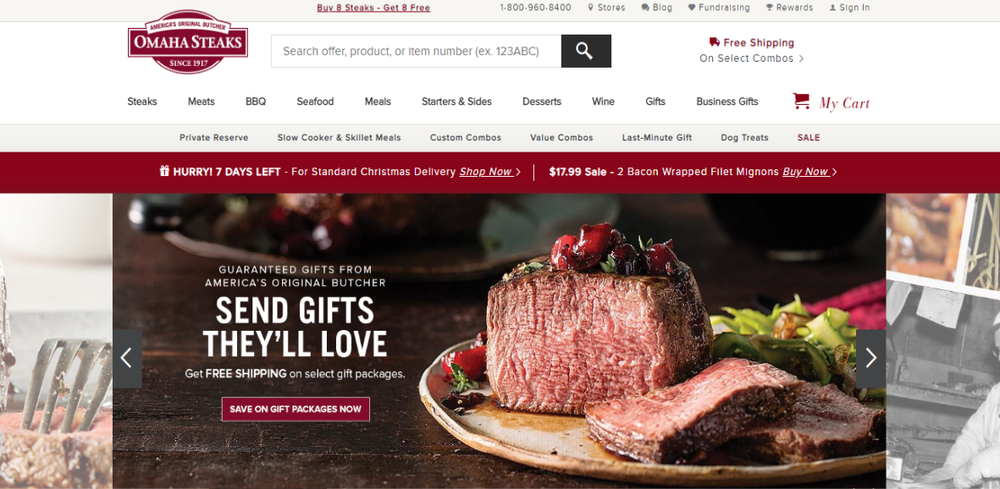
Possibly the longest running food subscription service is the family-run Omaha Steaks. Operating for more than 100 years now, these guys know how to source amazing meat for their customers. But, in a changing world where the food subscription market is blowing up so rapidly, how is this legacy company managing to stay afloat?
As a company, Omaha Steaks has always been right at the forefront of technological advances. When it first started trading, social media didn’t exist and SEO wasn’t a thing. The company’s biggest worry was keeping all that high-quality meat fresh. Throughout the years, Omaha Steaks has added direct mail, fax-ordering, in-store capabilities, e-commerce sites, and social media.
Omaha Steaks launched its own app and has a sizable following on Facebook (389.9K) to appeal to the platform’s older demographic (compared to the 13K followers the company has on Instagram). The Facebook store is set up so customers can buy directly through the social platform.
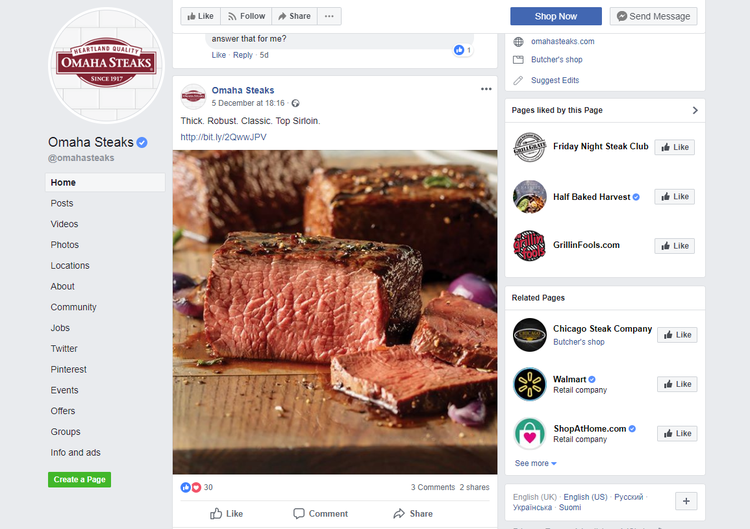
Omaha Steaks has also rolled out multiple deals on Groupon to entice new customers in. But, that hasn’t slowed down its direct mail marketing one bit. This is one where they cannot be built by anyone else – and they use it to keep existing customers sweet, and bring in new users.
You’ll also see an incredibly loyal customer case for this brand. They’ve been around for so many years, you would hope this would be the case, but they never rest on their laurels. Instead, they are always thinking of new ways to reward the loyalty they receive – and that is what makes them really stand out from the crowd. Especially with the amount of new brand shitting the market, knowing that this is one that they can trust really helps customers to keep investing their money.

SIMPLY COOK
One box that’s a little different from the others we’ve mentioned is Simply Cook. This box doesn’t deliver any fresh food to its customers, instead, it sends a selection of spices along with inventive recipes on how to use them. All their recipes are simple and easy to follow, but you’re left to source the majority of ingredients yourself.
So, how could they possibly compete against other boxes who supply everything but the kitchen sink? For one, they are much more affordable, with the UK boxes priced at just £3 a week. You may not be getting all the ingredients, but you are getting the recipes and the extra spices and sauces that are usually a little harder to find.
This is a box for those who love the idea of a food subscription box but aren’t yet convinced they want to drop that kind of money on their weekly food shop. All their recipes only require between four to six fresh ingredients, so you won’t be wandering the aisles looking for what you need. And the finished product serves between 2-4 people, just like the other similar boxes.
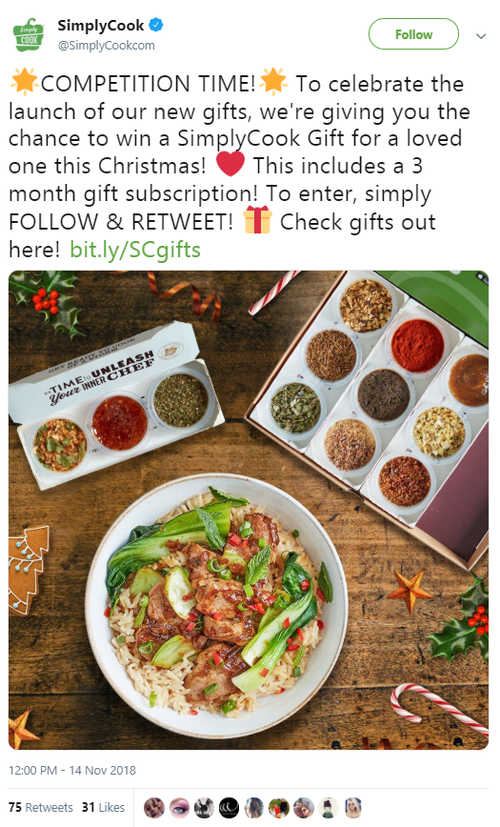
(Twitter)
They play on the fact that most people would love to cook more homemade food and inventive meals, but in reality, spend less time in the kitchen than ever before. Every inch of their marketing oozes with this approach, from the name “Simply Cook”, to the clean and simple website design. Simply Cook is another brand that has also spread its wings and dropped in-store products. In a team up with a big name supermarket, they created mini versions of their boxes for customer to purchase right then and there, along with the rest of their groceries.
And, thanks to the holiday season, they’ve even launched a special gift style box for Christmas. They ran a competition on Twitter to help promote this and gave away some boxes for free. All you had to do was follow their account and re-tweet the post in order to be in with a chance to win.
PURPLE CARROT
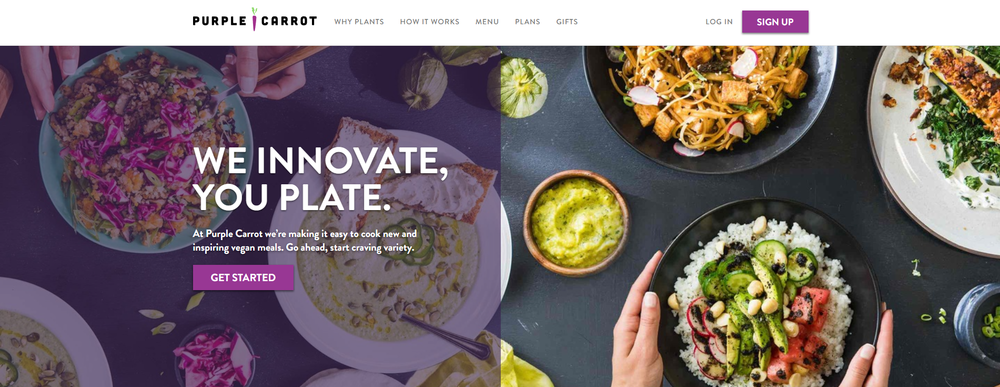
This holiday season, plant-based meal kit service Purple Carrot (on Instagram @purplecarrottxo) is promoting its 12 Days of Gifting. Each day, the company tells followers a benefit of gifting someone a Purple Carrot subscription and sweetens the pot with a bonus giveaway of a $100 gift card for a complementary online retailer – Farm Girl Flowers (on Instagram @farmgirlflowers). #plantlove
This post, in particular, is for Day 10. The caption lays out the process (with a link) for gifting a Purple Carrot subscription along with steps you need to take to enter the drawing to win the gift card. Smartly, the process requires entrants to tag a floral loving friend in the comments section, first to spark interest in Purple Carrot, and second to fortify the partnership between Purple Carrot and Farm Girl Flowers by broadening the San Francisco-based florist’s Instagram audience.

As well, there are two variations of this promotion, featuring two different images that have the same caption. That way, Purple Carrot can draw the attention of foodies who may happen across the image of the food because they follow one of the 12 vegetarian-theme hashtags included in the caption. Again, smart.

How Meal Subscription Companies Can Win
While food subscription services like the ones above continue to rise and expand, they’ll have to work even harder to stand out from the crowd. Making their boxes individual by offering slightly different services to their competitors will certainly make it easier. But, what else can they do to help secure success?
DIFFERENTIATE
What’s the real difference between your offering and your competitor’s offering – one that actually means something to your customers? For example, Purple Carrot (who is actually one of our clients – we ran influencer campaigns for Purple Carrot and got tons of UGC with some pretty cool outcomes), being the 100 percent plant-based meal kit brand is an automatic differentiator in a crowded market of chicken dinners. That alone, helps the company to continue growing. According to Purple Carrot CEO Andy Levitt, the company has “the strongest customer retention data in the industry.”
CONSIDER PARTNERSHIPS
While the convenience of having food delivered to your door is one of the main selling points of these subscription boxes, having some form of product available in stores is a great addition to a marketing strategy. The challenge is finding a partner that won’t force you to drive your prices down just to get on store shelves.
You’ll be able to attract and bring in new customers who prefer traditional supermarket shopping. By seeing your product in store during their grocery shop, it doesn’t seem as foreign an idea to them than simply ordering online.
You’ll also be allowing customers to try out your product before purchasing a regular subscription. Many of us already own subscriptions to Netflix, Amazon, Spotify and the local gym (most of which probably started with trial subscriptions).
CONSIDER AFFILIATE PROGRAMS
Affiliate programs like Groupon and Pinchme are a powerful source of both traffic and customer acquisition for subscription box services. Hitwise credits free sample site Pinchme.com with netting Graze a 10 percent boost in clicks.

BUILD ON SOCIAL MEDIA
For the most part, food subscription boxes are marketed to Millennials. If you’re not investing in social media, then you’re really missing a trick. With the amount of time this generation spends online, you’ll need to have a solid presence there, as well as something a little different.
Many of these brands have run competitions on their social media sites, which is always a great way to boost your stats and spread the word a little further about your product. Encouraging customers to share pictures of their finished meals – especially on Instagram – will also help to promote your brand to the perfect target market, the food obsessed.
BOOST RETENTION WITH EMAIL
More than overall retail, using email for continuous engagement with customers is especially useful in the subscription box space, according to Hitwise.
KEEP THINGS MOBILE-FRIENDLY
Remember your audience, and make sure they can easily navigate your site from their phones. Not just access it, but navigate – find what they’re looking for and make selections and purchases fast and easy.
Hitwise’s Subscription Boxes in 2018 report (which you can download here) identified mobile as the source for 65 percent of the traffic to subscription box sites, and 57 percent of the traffic to meal kit sites.
FOCUS ON VALUE
The big difference between these products is that the customer needs to keep returning month after month. So, these brands have to work extra hard to garner some real brand loyalty from their users. This goes well beyond just having a good product. Offering up incentives to stay with them, rewards for bringing in friends, and special VIP competitions are just some of the extra things they need to be doing.


